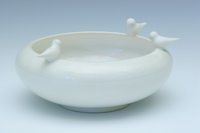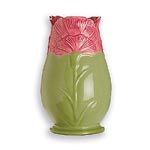I have been doing craft shows for 8 years now. I used to completely rely on them for my income, and I did many many shows, street fairs mostly. I don't knock street fairs because they helped me survive as a full-time artist for a couple of years. And it was in doing these shows where I paid my dues, and continue to occasionally pay my dues. If I have

given anyone the impression that I don't suffer for my art, let me now enlighten you. I suffer. I suffer at these shows.
Since I am totally masochistic, I actually get very excited about shows. I love setting up my little display, creating gorgeous flower arrangements in my vases, dressing up in my cool outfits. Since I usually look like a cross between a street urchin and a mud wrestler in my usual day to day attire, I never hesitate to buy beautiful clothes with the idea that I will look so damn cute selling my pottery in these shoes. Since I am what is considered an "established" artist, I can count on these shows to bring in a certain amount of income, I usually don't think too much about not doing well.
It wasn't always like this. Like I said, I paid my dues. I've done many shows where I've stood around all weekend and been alternately bored, angry, sad, and downright depressed as I watch my neighbors rake in the cash and I rake in admirers who have no money. I did one show in Napa about 7 years ago where I sold 3 things all weekend. THREE THINGS! I was so bummed out that I got outrageously drunk during the show-- this
was Napa and it
was a wine and music thing after all-- and cried so drunkenly and so loudly in the bathroom that everyone heard

me. And then there was the time in Santa Monica when my car got towed from in front of my sister's house the morning of the show, another exhibitor broke my best piece, and I had a bad case of laryngitis and couldn't even complain at the volume I like to. And another time when I did a show in Blackhawk--very upscale, very exclusive gated community-- and received not a glance from the patrons. Early on in the show, a little old lady wearing a Chanel suit and pearls came up to me, grabbed my best piece with both hands, paid for it in cash, and said bluntly, "You're not going to sell anything here". I said, "I think I'll do alright". I was not offended, but amused by her approach. "No," she said, "the people here know nothing of beauty, they hire interior designers to purchase things. They'll buy that crap over there" she snorted, gesturing toward one of my neighbors, who shall go unnamed. I just shrugged and said, "We''ll see", though I had to wonder if she was a future incarnation of myself, especially when she said the word "crap". Unfortunately, she was right, and despite being located next to a fully stocked bar tended by a sympathetic and attractive youngster, that was one show where I packed up and left hours before closing. Insult me, put me down, hate on my pottery, but nobody ignores me. And if they do... well see ya later!
I tell these stories with wry amusement because they are my war stories, and I can laugh now because I generally don't have bad shows anymore, and even what I consider a bad show is way better than what most people do at the same show. I never gloat-- though I do celebrate-- and I don't spend time being a complainer except at home. Today, I had a glaring exception. I had such a bad day that it rivals the Napa show, and in my household, that's
saying something. Napa is an iconic show of badness, so bad that when I have a bad day, me or my husband will say, "Well, at least it's not Napa". Today was Napa. Today was Napa squared.
I must have learned something in these years, because I didn't cry, I didn't get drunk-- not at the show anyway-- and I complained only to my closest friends and husband. I'm kind of bummed about the poor show, because I could have spent the weekend hiking or petting my cat, but not depressed or really upset, just surprised. Wow, nobody bought my work today except for a few lucky souls. Hmmmmmmmm.

 sliding off during the firing. I mostly solved this problem by throwing the bowls flatter on top so the flowers don't have a little hill to slide down. But still, I have this piece that's great except for the flower hanging off the side. I know some people will find this charming and buy it anyway, but then there's this empty spot where the flower was. And then on a couple of pieces, the flower started to slide down but got stuck early on, so the flowers is still on top, but flipped up on its side.
sliding off during the firing. I mostly solved this problem by throwing the bowls flatter on top so the flowers don't have a little hill to slide down. But still, I have this piece that's great except for the flower hanging off the side. I know some people will find this charming and buy it anyway, but then there's this empty spot where the flower was. And then on a couple of pieces, the flower started to slide down but got stuck early on, so the flowers is still on top, but flipped up on its side. all by themselves, with the intention of epoxying the flowers to the empty spots. Not perfect, but better then throwing them away. When the flowers came out of the kiln, I thought how gorgeous they looked, just sitting there by themselves. Then I started imagining a beautifully set table, with vases of flowers and the ceramic dogwood flowers scattered all over the table, like they had fallen from trees. Perfect for somebody having guests over for a special dinner!
all by themselves, with the intention of epoxying the flowers to the empty spots. Not perfect, but better then throwing them away. When the flowers came out of the kiln, I thought how gorgeous they looked, just sitting there by themselves. Then I started imagining a beautifully set table, with vases of flowers and the ceramic dogwood flowers scattered all over the table, like they had fallen from trees. Perfect for somebody having guests over for a special dinner! I could in three hours, and they come down to $5 a flower... wholesale. Not likely to be a big hit with most of my customers at that price. In my daydream time in the coming weeks I will be thinking about how to bring the price down: have the flowers molded? make them bigger? hire some oompa-loompas to live in my studio and make them? One way or the other, sometime this year you will be able to buy a package of ceramic dogwood flowers to scatter on your table, and I hope you don't have to gulp as you hand over your credit card!
I could in three hours, and they come down to $5 a flower... wholesale. Not likely to be a big hit with most of my customers at that price. In my daydream time in the coming weeks I will be thinking about how to bring the price down: have the flowers molded? make them bigger? hire some oompa-loompas to live in my studio and make them? One way or the other, sometime this year you will be able to buy a package of ceramic dogwood flowers to scatter on your table, and I hope you don't have to gulp as you hand over your credit card!















